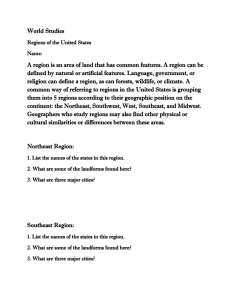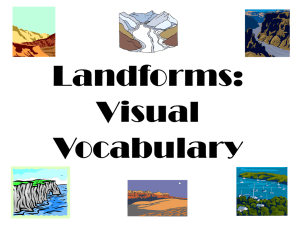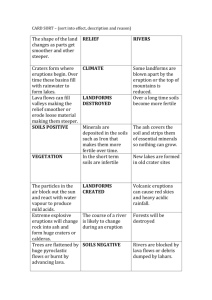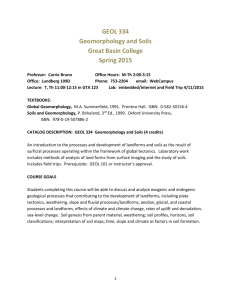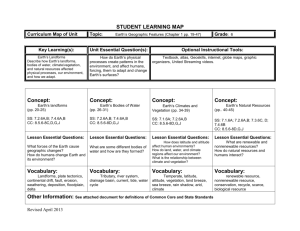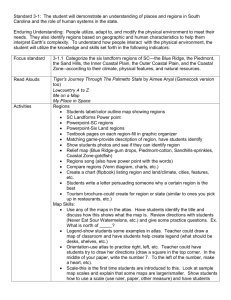Student_Objectives
advertisement
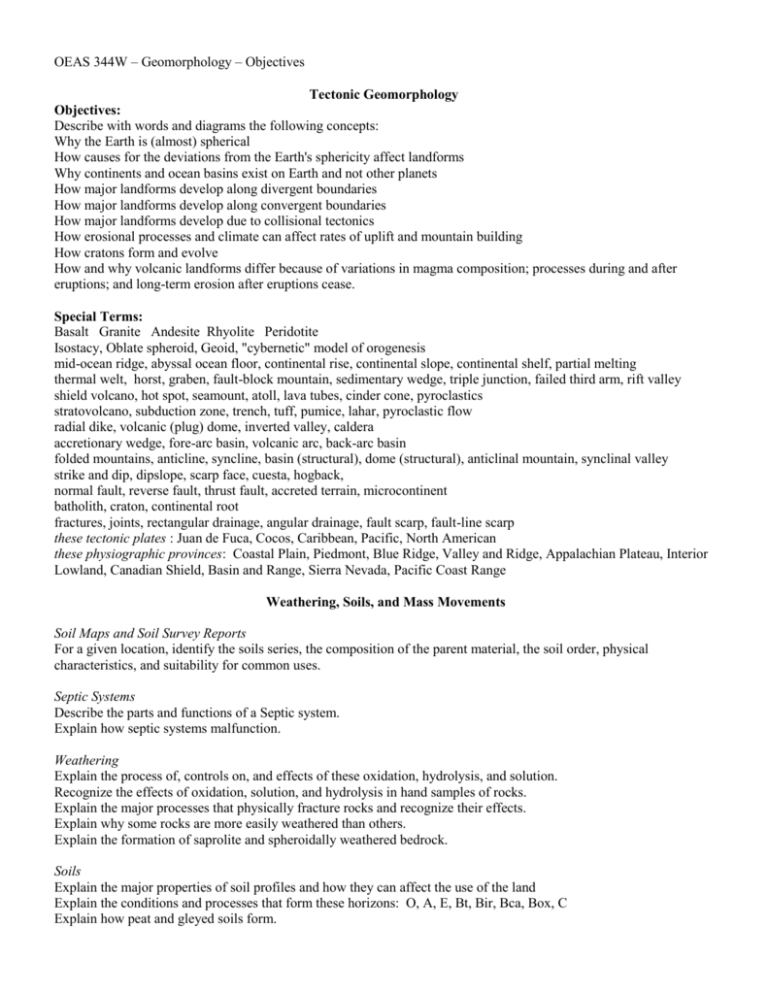
OEAS 344W – Geomorphology – Objectives Tectonic Geomorphology Objectives: Describe with words and diagrams the following concepts: Why the Earth is (almost) spherical How causes for the deviations from the Earth's sphericity affect landforms Why continents and ocean basins exist on Earth and not other planets How major landforms develop along divergent boundaries How major landforms develop along convergent boundaries How major landforms develop due to collisional tectonics How erosional processes and climate can affect rates of uplift and mountain building How cratons form and evolve How and why volcanic landforms differ because of variations in magma composition; processes during and after eruptions; and long-term erosion after eruptions cease. Special Terms: Basalt Granite Andesite Rhyolite Peridotite Isostacy, Oblate spheroid, Geoid, "cybernetic" model of orogenesis mid-ocean ridge, abyssal ocean floor, continental rise, continental slope, continental shelf, partial melting thermal welt, horst, graben, fault-block mountain, sedimentary wedge, triple junction, failed third arm, rift valley shield volcano, hot spot, seamount, atoll, lava tubes, cinder cone, pyroclastics stratovolcano, subduction zone, trench, tuff, pumice, lahar, pyroclastic flow radial dike, volcanic (plug) dome, inverted valley, caldera accretionary wedge, fore-arc basin, volcanic arc, back-arc basin folded mountains, anticline, syncline, basin (structural), dome (structural), anticlinal mountain, synclinal valley strike and dip, dipslope, scarp face, cuesta, hogback, normal fault, reverse fault, thrust fault, accreted terrain, microcontinent batholith, craton, continental root fractures, joints, rectangular drainage, angular drainage, fault scarp, fault-line scarp these tectonic plates : Juan de Fuca, Cocos, Caribbean, Pacific, North American these physiographic provinces: Coastal Plain, Piedmont, Blue Ridge, Valley and Ridge, Appalachian Plateau, Interior Lowland, Canadian Shield, Basin and Range, Sierra Nevada, Pacific Coast Range Weathering, Soils, and Mass Movements Soil Maps and Soil Survey Reports For a given location, identify the soils series, the composition of the parent material, the soil order, physical characteristics, and suitability for common uses. Septic Systems Describe the parts and functions of a Septic system. Explain how septic systems malfunction. Weathering Explain the process of, controls on, and effects of these oxidation, hydrolysis, and solution. Recognize the effects of oxidation, solution, and hydrolysis in hand samples of rocks. Explain the major processes that physically fracture rocks and recognize their effects. Explain why some rocks are more easily weathered than others. Explain the formation of saprolite and spheroidally weathered bedrock. Soils Explain the major properties of soil profiles and how they can affect the use of the land Explain the conditions and processes that form these horizons: O, A, E, Bt, Bir, Bca, Box, C Explain how peat and gleyed soils form. Explain the role or effect of the five soil forming factors. For each soil order, describe how and where it forms and its distinguishing features. Explain the importance of soil chronosequences, relict soils, and buried soils. Mass Movements For the processes of creep, rockfall, slide (slump) and flow, explain the forces that drive and control the process, and the materials and landforms that result from them. Explain the parts of the Coulomb Equation as it relates to hillside stability. Describe the common causes of hillside failures, both natural and anthropogenic. Recognize landforms that result from mass movements on aerial photos, topographic maps, and soil maps. Fluvial Systems Stream Hydrology: Explain the parts of a hydrograph (axes, baseflow, peak flow, lag time, etc.) Explain where the water goes when steady sustained rain falls on a fluvial landscape with relatively dry soils. The path that water uses to get to a stream is controlled by a number of factors (e.g. duration and intensity of the rainfall; antecedent rainfall history; soil moisture/saturation conditions; soil and rock characteristics; where the water lands; shape of the hillside; etc.) Explain how these factors can influence the response of a drainage basin to a storm (i.e. make the shape of a flood hydrograph “flashy” or not). Explain how stream basin shape, size, and gradient can affect the shape of a flood hydrograph. Describe the steps and graphs needed to establish and use an automated stream gaging station. Explain how to construct a flood frequency curve and how to estimate the discharge of the “hundred-year flood.” Also, how to calculate the probability that a flood of a given size at one site will or will not reoccur during a given time period. Fluvial landforms: Describe how floodplains and terraces form, and the factors that control the thicknesses and textures of the sediment present beneath a floodplain or terrace. Explain what relationships exist between the Q2 (or Q1.5) and Q50 floods and measurable geomorphic features. Use examples from a meandering river floodplain to explain the concepts of “dynamic equilibrium,“ “graded stream,” and “equilibrium landforms” (e.g. floodplain surface; meander shape and size; pool and riffle sequence; longitudinal profile). Describe how those features formed and their characteristics. Explain which characteristics of an alluvial channel can be used to estimate the texture and thickness of floodplain sediments and why they can be used to make this inference. Explain the concept of base level, what controls it, how it can change, and what effect that change can cause. In particular, relate how base level changes can be related to headward erosion of knickpoints (waterfalls), terraces, incised meanders and long-term incision by streams. Describe how humans can alter the geomorphic equilibrium established by alluvial streams and the expectable reaction of the stream. Coastal Geomorphology Explain how ocean waves form and travel and how they change as they approach shorelines and expend their energy. (storms, swell, wave characteristics, fetch, surf, swash, backwash, refraction, etc.) Describe the origins and movement of sediment on a beach, using cliffed beaches in California and barrier beaches in Virginia as examples. (headlands, cliffs, stacks, arches, wave cut platform, ancient examples of these, cove beaches, shells, heavy minerals, rocks, sand, rivers, lagoons, estuaries, deltas, Chesapeake Bay, source areas, etc.) Explain how, when and where sediment moves along the beach and on and off shore and what landforms develop because of these movements. (backshore dune and berms; foreshore beach face, runnel and ridge; nearshore bars and troughs; spits and barriers; etc.) Describe why and how barrier islands migrate landward and prograde seaward (washover, sea level rise, inlets, flood and ebb tidal deltas, facies on a transgressive and a prograding barrier island; etc.) Explain why and how inlets form and evolve. Describe how tidal action and sediment supply control the overall shape and size of barrier island. Recognize all of these landforms on topographic maps or aerial photographs. Glaciers and Glaciation Describe how glaciers differ according to size and movement, and according to temperature regime. Explain how glacial ice forms and moves. Describe how crevasses form and what they reveal about the movement of ice. Explain the major processes of glacial erosion and the landforms created by glacial erosion. Describe how and where glaciers, and their associated meltwater and wind, deposit drift, especially focusing upon how and why these deposits differ in shape and composition. Explain several types of geomorphological evidence that indicate climates have changed during the Quaternary. Describe the processes that cause glaciers to both grow and shrink in size radically over time scales of 10,000 to 100,000 years. Explain why extended periods of (multiple?) glaciations can last for tens of millions of years or longer, even though these periods are unusual events during the history of our planet.

